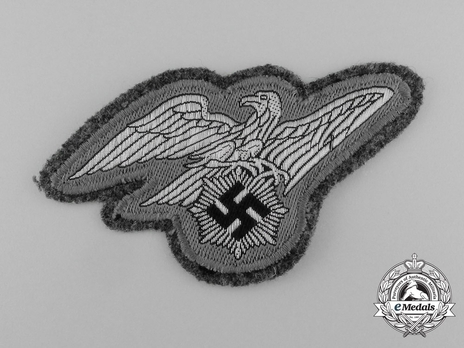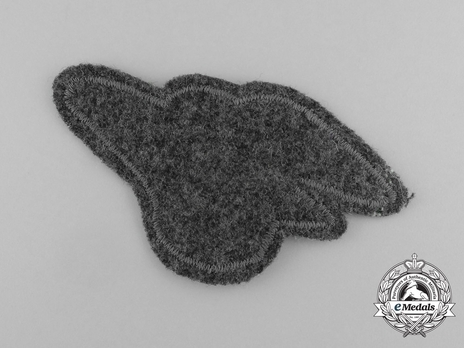RLB Sleeve Eagle (2nd pattern)
CATEGORY: Version
SKU: 56.GOR.03.02.04.001.001
Estimated market value:


Estimated market value:
Constructed of fine silver aluminum bullion and black machine embroidery; with a grey embroidered backer; on a Luftwaffe grey wool backer; measuring 100 mm x 57 mm; better than extremely fine condition.
Air raid protection organisations existed during the time of the Weimar Republic in the 1920s. However, in preparation for a coming war, a greater need for a centralised organisation under NSDAP control arose. It was established mere months after the NSDAP took control of Germany. The Reichsluftschutzbund (National Air Raid Protection League) or RLB was founded on April 29, 1933 under the control of Hermann Göring as Minister of Aviation. Naturally, its leader, as well as the nature of the organisation’s tasks, meant that the RLB would always have close ties to the Luftwaffe. All previously founded air raid protection organisations ceased to exist or were forcefully absorbed into the RLB.
The RLB’s function was to train the public on how to prepare for and deal with enemy air raids, and act as a supervisor of civil protection and defense, for both private homes and for places of work. Therefore, the RLB’s focus was split up into what was referred to as Selbstschutz (self-defense) for homes and Erweiterter Selbstschutz (extended self-defense) for places of work. Air raid protection of industry that was deemed essential to the war effort was referred to as Werkluftschutz (Factory Air Raid Protection) or WLS.
The core of the organisation was made up of high-ranking Luftwaffe officers (the RLB leader was always a Luftwaffe General) and a number of full-time salaried RLB members. These professional RLB members made up only a minority of the organisation, since the vast majority of members were, in fact, volunteers. Eventually, a law passed on June 26, 1935 made it a legal duty for almost everybody to receive training by the RLB.
In May of 1937, the Sicherheits- und Hilfsdienst (Security and Assistance Service) or SHD was founded. This was meant as a sister organisation of the RLB made up of professionals rather than amateurs, including firefighters, medical personnel, and specialist troops like public utilities repair service, gas decontamination service, or salvage crews.
At the same time, the Luftschutzwarndienst (Air Raid Warning Service) or LSW was founded. It was intended as an intermediary between the Flugmeldedienst (Flight Message Service) and the air raid protection organisations. The Flugmeldedienst was responsible for spotting enemy aircraft and determining their likely targets, so the population could receive a warning before an attack was carried out.
The SHD was split in the spring of 1942, with the Luftwaffe taking control of its mobile (motorised) units, and the Police taking control of its static units under the name of Luftschutzpolizei (Air Raid Defense Police).
The water-related units were formed into a new organisation, the Wasserstraßenluftschutz (Waterways Air Defense) or WSL. This organisation was entirely separate from and not affiliated with the Wasserschutzpolizei, the Water Protection Police. The WSL’s creation was officially announced on June 1, 1942.
The RLB sleeve eagle insignia was used in two different patterns.
The 1st pattern was introduced on March 7, 1934 and worn on the upper left arm. It is in the form of a circular cloth backing in blue-grey with an early “political” eagle emblem, embroidered in silver bullion for Officers and white cotton for lower ranks.
The 2nd pattern was introduced in October of 1938. The “political” eagle was replaced by the newly introduced RLB eagle, which flies to the viewer’s right, but looks to the viewer’s left, and holds an eight-sided star with a black swastika in its talons.
The eagle is made of silver-coloured bullion for Officer’s, either hand-embroidered or machine-woven, and hand-embroidered gold-coloured bullion for Generals. Lower ranks wore a machine-woven version in grey. Contrary to the 1st pattern, the 2nd pattern insignia was worn on the lower left arm.
Women wore the same 2nd pattern eagle emblem, but on the upper left arm.

Comments
Sign in to comment and reply.


Scroll Top